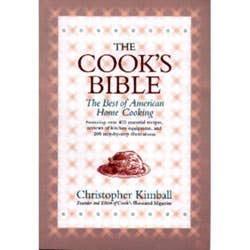
Food And Hoo-Haw
Every evening, back in my misspent youth as a newspaper sportswriter, there came a witching hour we called "bar time". That was when sports fans—sober enough to argue, drunk enough to care—would call up asking us to settle their disputes: Who was the better pitcher, Koufax or Maris? Who was the better hitter, Mays or Mantle? This was of course pure silliness, more like the little boy's game of "Who would win, Godzilla or Superman?" than any real debate. When I left sports-writing behind, I thought I'd heard the last of those kinds of arguments.
Lately, though, I've been noticing more and more of them in food. Of course, there have always been arguments about recipes. (What? You put beans in your chili?) Until recently, these were generally acknowledged to be disagreements of taste. (Maybe you happened to like chili with beans.) Now, however, there is a new wave of culinary writing that seeks to raise recipe testing to the level of science. I've done it myself. At the heart of these efforts is the fact that cooking—or the transmission of such cooking knowledge—has changed a lot over the last 50 years. In the past, where you stood on such things usually depended on where your mother stood.
There are plenty of good things about this kind of education. For one, it saves time. For another, by cooking alongside a master, you learn the hundreds of little things that make a good cook but that are so hard to communicate in the bare-bones prose of a recipe. The downside, of course, is that an awful lot of culinary lore is pure hoo-haw. Being passed down through several generations doesn't automatically make a thing true. It just gives it a patina.
Although the traditional method of instruction has largely been lost, thanks to two or three generations of convenience food cooking, many of its myths remain. Distinguishing myth from truth is valuable work—but it's important for the writer undertaking this task to make sure that he's not perpetuating myths of his own.
One of the leading myth-bashers in American food writing today is Christopher Kimball, founder and editor of Cook's Magazine, which has been resurrected in a slightly different form as Cook's Illustrated. Kimball's book, The Cook's Bible, includes many of his pieces for both, along with the charts and how-to illustrations for which Cook's Illustrated is justly famous. How to pick out pots and pans, which is the best knife to buy, how to steam rice—Kimball answers these and a hundred other questions here—and there is much to praise in what he has accomplished. On matters both basic (what is the right balance of oil to vinegar in a salad dressing?) and esoteric (how do you dry-roast quinoa?), Kimball delivers clear, commonsense information. His chapter on outfitting a kitchen may be worth the price of the book for many beginners. (Even after years of cooking, I never knew that the little hole on the bottom of a food processor feed tube is to allow the thin thread of oil necessary to begin making mayonnaise. O.K., so maybe I should have read the owner's manual.)
Overall, though, there is more dogma than philosophy in Kimball's book. He frequently falls victim to extreme and sometimes questionable prejudices. And there are holes in many of his arguments. Inevitably, I find him most correct when he agrees with me. He is right, for instance, when he dismisses the tenderizing effects of marinades; the acids simply can't penetrate deep enough to affect more than the surface of the meat. But at other times, I find him perplexingly wrong-headed. Take beans, for example. I've looked into the subject quite a bit and have decided that presoaking dried beans is next to useless. It does nothing to eliminate the oligosaccharides that cause most of the, um, flatulence (and incidentally, these are sugars, not enzymes as Kimball says), and it only moderately decreases the cooking time. Kimball asserts on the one hand that overnight soaking is necessary, but on the other argues that, in a pinch, it's better to cook beans without soaking at all than to do the quick presoak. He somehow apparently never bothered to test without soaking at all. Kimball is likewise stubborn about the supposed advantages of low-temperature roasting. He roasts a chicken at 375° and finds it admirable, yet he insists on recommending a convoluted technique that involves starting the chicken at 375°, reducing it to 200° after an hour, and then increasing it to 400° for the last 15 minutes. About halfway through this laborious process, you want to shake him by the shoulders and shout: "Chris, it's just a goddamned roast chicken, for heaven's sake!"
More troubling is Kimball's tendency to expound on scientific principles of which he has only a shaky grasp. Under the heading "Science of Cooking", for example, he explains that "Browning meat develops tremendous flavor because the sugar in the meat begins to caramelize, a process known as the Maillard reaction." Wrong and wrong again. The Maillard reaction does not involve caramelizing sugar, though it usually happens at the same time. It is a separate series of chain reactions that occur when amino acids and sugars are heated together. That's why roast chicken doesn't taste like creme brulee (or, more to the point, why it doesn't taste like_ poached_ chicken).
In the end, Kimball seems more fascinated with reducing all aspects of cooking to a few unbreakable rules than with truly exploring how food works or with preparing delicious meals. Broccoli must be steamed no more than seven minutes. To correctly cut the fat into a pie crust, you must pulse the food processor five one-second pulses and then four one-second pulses. Oh, and his affection for low-temperature roasting? That's how his mom does it.
Keep Reading
Continue to Next Story










